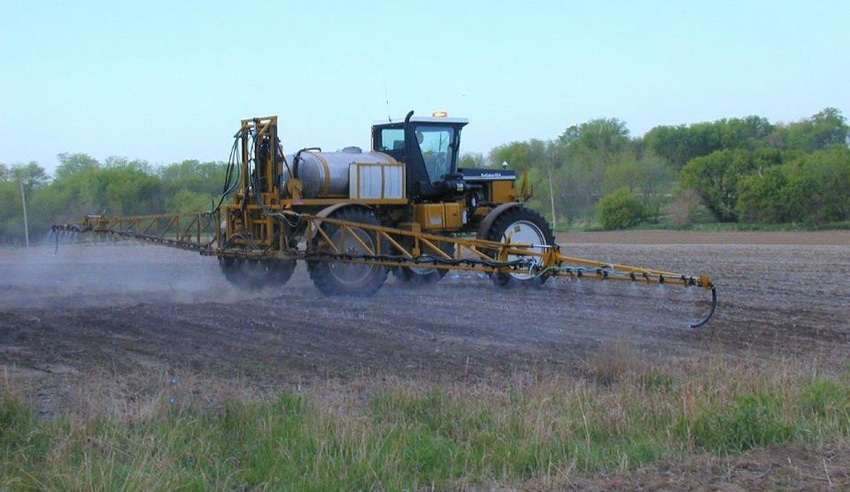June 12, 2018

Source: University of Nebraska-Lincoln
By Clyde Ogg, Greg Puckett and Cheryl Alberts
Good housekeeping is a definite must when it comes to agricultural sprayers. Even traces of pesticide residue in a cleaned sprayer could invite crop reduction or loss, especially when using the same sprayer for various types of herbicides.
Both self-propelled and pull-type spraying systems have complicated plumbing. To prevent contamination from spray residue, clean every nook and cranny, including tanks, valves, baffles, and hoses. A 120-foot sprayer has 96 nozzles and screens — lots of places for residue to hide. Dirty screens can continually contaminate the rest of the system, and as much as 15 gallons of residue can remain in the system after cleaning.
Hose quality also affects how clean a sprayer can get. The higher quality, the better. Poorer quality hoses that crack allow residues to be impregnated in the hose. Tests at Mississippi State University show a synthetic rubber hose had the greatest herbicide carryover damage. An ethylene-centered hose had better cleanout.
Even minute amounts of residual herbicide can affect a crop: One drop of dicamba can cause significant visible crop response on nearly three acres of conventional soybeans. If just one drop of herbicide can visibly affect a crop, 15 gallons of spray solution can do much more damage — especially if the next crop sprayed is a specialty crop, fruit or vegetable.
The following steps can help ensure a clean sprayer:
•Clean all spray equipment as soon as possible after use. The longer a cleaner can be left in the sprayer and the more it can circulate through the booms, the better. Residues left in the sprayer can gum up and become even harder to clean out.
•Follow all label instructions — it's the law.
•Use the right products, including plenty of water and cleaning compounds.
•Allow the correct amount of time for cleaners to work.
Also check guidelines in the newly revised NebGuide, Cleaning Pesticide Application Equipment (G1770).
Rinsate from Cleaning
Before cleaning spray equipment, check the label directions, which vary for different pesticides. The label is the law.
In general, rinse water from cleaning may be applied to the field or site of application.
New Cleaning Product
A new sprayer system cleaner introduced this spring is designed to break down dicamba. The product uses a chemical deactivation process that is effective if reaction time is sufficient; however, the principles of good sprayer hygiene are still necessary. This tool, from Monsanto and Adjuvants Unlimited, is expected to help minimize off-target effects.
PPE
Always wear proper personal protective equipment, again referring to the label. Does the label state to wear goggles? A chemical-resistant apron? Pay attention and follow these instructions. The right combinations of PPE may reduce pesticide exposure by up to 90%. At minimum, wear a long-sleeved shirt, long pants, shoes, socks and chemical-resistant (not leather or cotton) gloves.
After you've completely cleaned your spray equipment:
•Avoid contact with other people.
•Don’t eat, drink, chew gum, use tobacco or use the bathroom until you and your clothing are properly cleaned.
•Wash gloves thoroughly before removing.
•Remove outer clothing outdoors and shower immediately.
•Wash clothing separately from other laundry, using the hottest water and longest cycle available.
•Safely discard heavily contaminated clothing.
Checklists
One of the best ways to ensure all the parts of a sprayer have been cleaned and that all the cleaning steps have been taken, is to follow a checklist. Sprayers vary, so make up your own list for your sprayer.
Resources
•Removing Dicamba Residues from Your Sprayer: A Tricky Task
•Watch Sprayer Hose Type for Herbicide Carryover — (Greenbook.net)
•Cleaning Pesticide Application Equipment (2016 CW)
Greg Kruger, UNL weed science and application technology specialist, demonstrates how to clean a field sprayer in this video from UNL's Pesticide Safety Education Program. Find more than 40 videos on its YouTube Channel, UNLExtension PSEP.
Kruger notes: As much as 15 gallons of product can remain in the tank after it's been emptied, due to the volume in the lines and filters. A thorough cleaning can help avoid contamination.
You May Also Like




